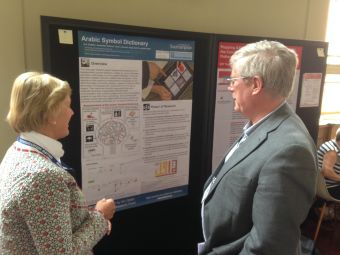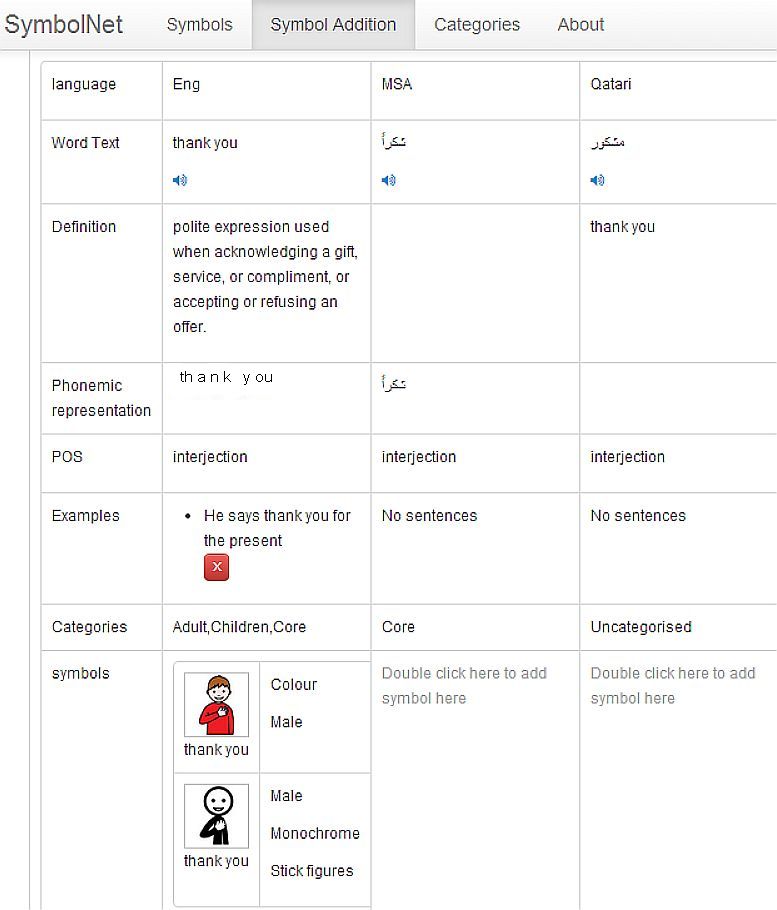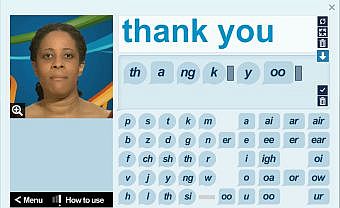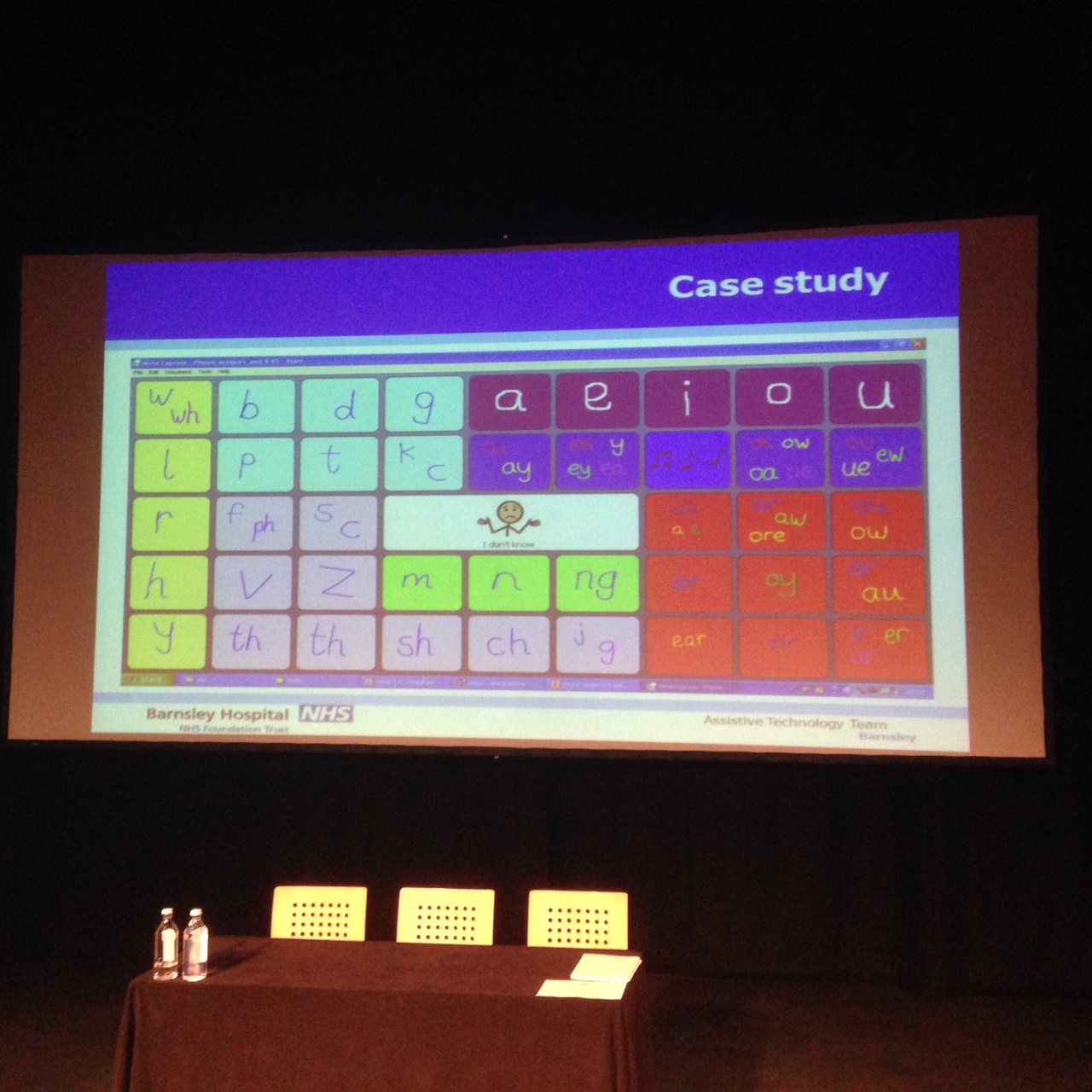Communication Matters 2014 was a really interesting conference with many topics related to the work on the Arabic Symbol Dictionary and a chance to test some of our ideas related to phonic awareness and the lexical entries. There was also time to catch up with many of the experts in the field as can be seen from the list of presentations.
In most talks there was an assurance that the slides presented would be available on the Communication Matters website in the coming weeks.
Chris Abbott, as an Advisory Group member, took time out to discuss the poster as did Alasdair King from ClaroSoftware and many others who were passing. I learnt more from the Barnsley Assistive Technology team and Marion Stanton – both giving very interesting talks.
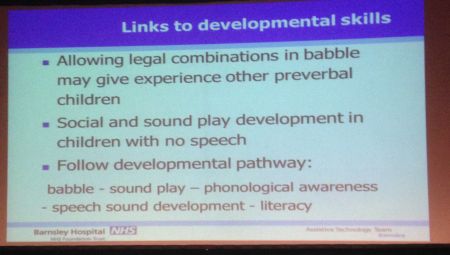 Andrea Kirton and Simon Judge talked about their Phonic Screen ideas for “Using Phonemes to Construct Utterances for Aided Communication”. This was mentioned in the previous blog but here you can see from one of their slides that they see presenting phonemes with speech output as supporting many essential developmental skills.
Andrea Kirton and Simon Judge talked about their Phonic Screen ideas for “Using Phonemes to Construct Utterances for Aided Communication”. This was mentioned in the previous blog but here you can see from one of their slides that they see presenting phonemes with speech output as supporting many essential developmental skills.
There is a useful booklet developed by Lancashire Primary Literacy team (download PDF) that highlights the complexities of gaining phonemic awareness in English and this was also debated in Marion Stanton’s very thought provoking presentation. She stressed the need to think about presenting text instead of symbols in particular where there were abstract words that were often seen with totally unrelated images for the word such as ‘equals’ for ‘is’ or ‘are’. Marion said input and output must achieve “Time, energy and effort efficiency”. She discussed the idea of using phonics on Grid 2 as a bridge to synthetic phonics with one student who is now taking A’levels. This was also shown by TechCess in Mindexpress 4.
 Grid 3 developed by Sensory Software was also demonstrated by Barney Hawes with its new Windows 8 look that complements the free download of Grid Player Grid 3 allows for editing on a tablet or other touch screen device and has the Microsoft Office type ribbon – it also possible remotely edit and update grids.
Grid 3 developed by Sensory Software was also demonstrated by Barney Hawes with its new Windows 8 look that complements the free download of Grid Player Grid 3 allows for editing on a tablet or other touch screen device and has the Microsoft Office type ribbon – it also possible remotely edit and update grids.
Jennifer Marden from Assistiveware who develop Prologquo2Go gave a helpful presentation which she has kindly shared called “Teaching with Core Words” (Download PDF) – she listed a number of references that can be found below.
Finally whilst following tweets from the Ace Centre I learnt about a very useful clinical guidance document from the Australian Speech Pathologists which covers some of the ethical issues we have discussed such as consent forms.
References
Balandin, S., & Iacono, T. (1998). A few well-chosen words. Augmentative and Alternative Communication, 14(September), 147–161.!
Balandin, S., & Iacono, T. (1999). Crews, Wusses, and Whoppas: Core and Fringe Vocabularies of Australian Meal-Break Conversations in
the Workplace. Augmentative and Alternative Communication, 15(June), 95–109.!
Banajee, M., Dicarlo, C., & Buras Stricklin, S. (2003). Core Vocabulary Determination for Toddlers. Augmentative and Alternative
Communication, 19(2), 67–73.!
Beukelman, D., Jones, R., & Rowan, M. (1989). Frequency of word usage by nondisabled peers in integrated preschool classrooms.
Augmentative and Alternative Communication, 5(4), 243–248.!
❖ Beukelman, D. R., Yorkston, K., Poblete, M., & Naranjo, C. (1984). Frequency of Word Occurrence in Communication Samples Produced
by Adult Communication Aid Users. Journal of Speech and Hearing Disorders, 49(November), 360–367.!
Clendon, S., & Erickson, K. (2008). The vocabulary of beginning writers: implications for children with complex communication needs.
Augmentative and Alternative Communication, 24(4), 281–93.!
Fried-Oken, M., & More, L. (1992). An initial vocabulary for nonspeaking preschool children based on developmental and environmental
language sources. Augmentative and Alternative Communication, 8(March).!
Lahey, M., & Bloom, L. (1975). Planning a First Lexicon: Which Words to Teach First. Journal of Speech and Hearing Disorders, 340–351.!
Marvin, C., Beukelman, D. R., & Bilyeu, D. (1994). Vocabulary-Use Patterns in Preschool Children: Effects of Context and Time Sampling.
Augmentative and Alternative Communication, 10(December), 224–236.!
Van Tatenhove, G. M. (2009). Building Language Competence With Students Using AAC Devices: Six Challenges. Perspectives on
Augmentative and Alternative Communication, 18(2), 38–47.!
Yorkston, K., Dowden, P., Honsinger, M., Marriner, N., & Smith, K. (1988). A comparison of standard and user vocabulary lists.
Augmentative and Alternative Communication, 4(4), 189–210.!
Yorkston, K. M., Beukelman, D. R., Smith, K., & Tice, R. (1990). Extended communication samples of augmented communicators. II:
Analysis of multiword sequences. The Journal of Speech and Hearing Disorders, 55(2), 225–30.!
Yorkston, K. M., Smith, K., & Beukelman, D. (1990). Extended communication samples of augmented communicators. I: A comparison of
individualized versus standard single-word vocabularies. The Journal of Speech and Hearing Disorders, 55(2), 217–24.
Speech Pathology Australia (2012). Augmentative and Alternative Communication Clinical
Guideline. Melbourne: Speech Pathology Australia. Accessed 22/09/2014 http://www.speechpathologyaustralia.org.au/library/Clinical_Guidelines/24072012%20FINAL%20Augmentative%20and%20Alternative%20Communication%20Cl.pdf

